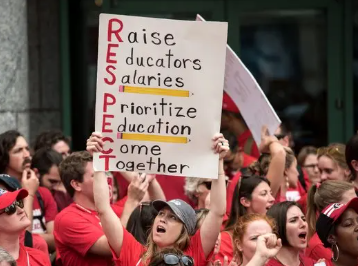Pay Teachers More, Or Cost Our Future

by Justin Lakso ‘25
Teachers are the backbone of the future. They work countless hours and deal with constant stress in both their professional and personal lives to give students the best possible chance to succeed in the future, especially if the student wants to go to college. Unfortunately, teachers’ salaries don’t reflect their hard work. The biggest issue with low teacher salaries is that it is decreasing the number of people who will want to become a teacher. “A career in education must not be a lifetime sentence of financial worry,” says National Education Association President Becky Pringle. “Who will choose to teach under those circumstances?”
It’s easy to say “just pay teachers more,” but the real issue is how to do it. Salaries can wildly differ between areas because school budgets are organized at the district level and largely come from property taxes of the residents. This means poorer areas have school districts with less money, which means they often have less to pay teachers. For example, Montgomery County has an average salary of $85,000 while Kent County in Maryland pays its teachers an average of $58,000. This could be solved with Blueprint for the Future signed into law in Maryland. It guarantees all salaries must start at $60,000 beginning in 2026. Although the average starting salary for a bachelor’s degree in any profession is $68,000, this is still a good start. Even still, there are also other solutions that could be implemented.
First of all, teachers should be paid more in the first years of their career instead of saving larger pay raises past the 10-year mark. In MCPS, teachers get $1,500 to $2,200 added to their salary each year (starting at $1,500 and gradually increasing to $2,200) and after 10 years, their pay begins increasing more rapidly ($2,500-3,000 per year) until the 25-year mark where it stays stagnant. Instead of this 25-year plan, teacher’s pay should receive a flat percentage increase per year, and the salary should cap after 20 years instead of 25. The percentage increase would have to be determined by the school district. This would mean teachers would end up with a slightly lower final salary, but it would be more than made up with a higher salary year-to-year earlier in their careers.
An alternative method to funding schools could be to organize funding at the state level instead of the district level. Each school wouldn’t have to worry about district population size and property taxes; instead, each school would have funding proportional to its size. Counties would contribute to this state funding through their local property taxes. These are only a few of the ways to adjust teacher salaries to make the job more appealing and rewarding, which must be implemented to keep teachers afloat in the future.